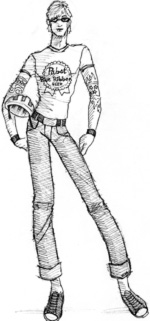By Abby Glogower
For four days in October a curious sight greeted passersby along the Ashland and Archer overpass: ‘P-I-L-O-T-W-O-O-D’ read the grassy hill in legendary white Hollywood cutouts. Next door, the Texas Ballroom/ Diamonds complex, having converted their home into a multi-stage, round the clock production studio, was whirring with activity: The Pilot TV Conference: Experimental Media for Feminist Trespass had landed. Billed as a “perverse amalgam of television studio, anticapitalist art space, and trans-activist workshop,” Pilot was a massive group endeavor many months in the making.
What began as a conversation between two young Chicago artist/activists quickly grew to a core of 25 committed organizers and drew close to 100 responses to the convergence’s call for submissions. Participants arrived from all over the country and, working together over the weekend, produced hundreds of hours of alternative television programming. Over sixty programs were shot, ranging from performance pieces, talk shows, panel discussions, lectures, and concerts, to informational workshops covering topics as diverse as bike repair, safer leather sex, and border crossing.
The staggering breadth of projects reflects the organizers’ desire to bridge different kinds of activism: feminism, trans politics, space reclamation, and media. “Participation and collaboration are critical to our aesthetic,” says organizer Emily Foreman, who modeled the Pilot conference after the “Department of Space and Land Reclamation” event from 2001, in which artists and activists took over sites around the Chicago area for performative ephemera and protest.
Participation was critical to the goal of breaking down standard hierarchical processes of production. Free and open to the public, thanks to months of committed fundraising efforts, the options for involvement at Pilot were as diverse as shooting a scene for a movie, helping facilitate a demonstration on camera equipment, cooking a community meal or simply being an enthusiastic audience member. By opting for a pluralistic approach to art-making as catalyst for social change, Pilot created a space where identities could be freely chosen, individually defined and supportively explored. Described as “extreme gay art-camp” by one glowing out-of-town participant, the event was widely regarded as a great success.
The results were as rich and varied as the project’s foundations. The name Pilot, after all, emerged from a complex intersection of meanings: questions exploring physical flight and bodily control encoded in the television industry’s term for a trial first episode. Will Pilot fly again? The exhausted organizers are certain that in some form it will. “We’ve planted seeds that people will take with them and use to generate more ideas and events,” says Foreman.
For those who missed the conference, there is still ample opportunity to take part in the extensive post production efforts. For information on how to get involved and for detailed descriptions of projects, please visit: www.pilotchicago.org
November 2004








